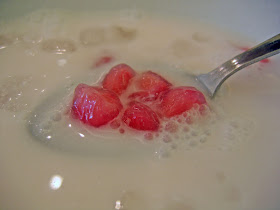Pages
▼
Tuesday, 9 February 2010
tab tim grob - thai dessert
Tab Tim Grob (ท้บทิมกรอบ) is also known as Tabtim Grawb or Tup Tim Krob, but in English it’s known as Red Rubies.
This Thai dessert, made from water chestnuts, is a seemingly weird combination to serve in a sweet course, but surprisingly it works very well.
Although water chestnuts are usually served with savoury dishes, they don't have much flavour on their own so their wonderful crunchy texture takes on the sweetness of the surrounding coconut milk.
Be brave and this dessert will reward you.
Tab Tim Grob (Thai Water Chestnut Dessert)
Recipe from asiafood.org Serves 4.
Ingredients:
250ml coconut milk ice
220g canned water chestnuts
185g white sugar
185ml water
Approx. 4 tablespoons tapioca flour
Few drops jasmine or rose essence
Few drops red food colouring
¼ teaspoon salt
Sliced jackfruit, for serving
Crushed ice, for serving
Method:
1. Halve canned water chestnuts into bite sized pieces.
2. Put into a bowl and add just enough cold water to cover. Drop food colouring into the water, stirring, until there is a strong red colour.
3. Add a few drops of rose essence.
4. Leave water chestnuts to absorb the colour for 15-20 minutes. When the water chestnuts have absorbed enough colour, drain in a sieve.
5. Meanwhile, dissolve sugar and water in a saucepan to make syrup. Allow to cool.
6. On a sheet of paper spread the tapioca flour and roll the pieces of water chestnut in the flour until well coated. Put the water chestnuts in a dry sieve and shake off excess flour.
7. Bring a saucepan of water to the boil. Drop into the boiling water and cook until the pieces rise to the surface. Lift out on a slotted spoon and drop immediately into a bowl of iced water.
8. Mix the coconut milk with the salt.
9. In each serving bowl or glass pour some of the syrup, then spoon in some water chestnuts. Gently pour in some of the coconut milk, scatter in a few slices of jackfruit and last of all add a spoonful of crushed ice. Serve at once.
This is my contribution to Weekend Herb Blogging, but I have already blogged about water chestnuts in the past, so forgive me for stealing from my own posts:
The Chinese water chestnut Eleocharis dulcis is a sedge (water grass) that grows in freshwater swamps, marshes and flooded rice fields. Its tubular, leafless stems can grow to 1.5 metres tall, although it is cultivated for its corms.
In fact the white corms remain crisp even after cooking, making them popular in Western-style Chinese food. The corms can be eaten raw, boiled, grilled or pickled. They can be even ground down to make flour.
Nutritionally, the water chestnut is rich in carbohydrates as well as dietary fibre, vitamin B6, potassium, calcium, iron, potassium and zinc. But watch out – uncooked fresh water chestnuts can pass on Fasciolopsiasis, an intestinal infection caused by parasitic flukes (worms).
Water chestnuts grow in many varieties across China, South East Asia, India, Polynesia, New Guinea and northern Australia. In the Northern Territory, the native Australian variety is small, sweet and a food source for millions of birds.
For other WHB recipes, check out the recap from my blogging pal, Chris from Mele Cotte.



I would never have thought of using water chestnuts in this way! I do love their texture though.. They are obviously more versatile than I thought.
ReplyDeleteI love the idea of water chestnuts in a dessert! So interesting and intriquing! Thanks for participating in WHB!
ReplyDelete